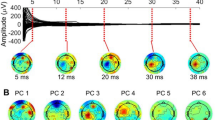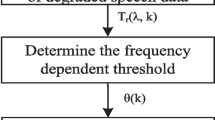Abstract
In this paper, an enhanced independent component analysis (ICA) method is proposed for blind separation of noisy mixture signals. Considering the conventional ICA methods always have an inadequate capacity of resisting noisy effect. This phenomenon is usually encountered in wireless receiving processing. To obtain the improved separation quality, two mechanisms are conducted to formulate the modified cost function and the powerful optimization learning for investigating an enhanced ICA method.The fundamental of the proposed method is derived from the minimum bit error rate (BER) criterion and the Nesterov-accelerated adaptive moment estimation (Nadam) optimization approach. The main work of this paper includes the following facets. Firstly, a maximum likelihood (ML) principle cost function with minimum BER constraint is derived. Secondly, the modified cost function is by utilizing Nadam learning processing. Lastly, theoretical analysis and experiment results verify the improved performance quality of the proposed enhanced ICA method compared with popular representative ICA methods.




Similar content being viewed by others
References
Rosângela, F. C., Vítor, H. N., Ricarde, L. D. Q., et al. (2016). Signal and images: Advances and results in speech, estimation, compression (pp. 3–23). Boca Raton: CRC.
Yu, X. C., Hu, D., & Xu, J. D. (2014). Blind source separation theory and applications (pp. 19–166). Tower: Wiley.
Comon, P., & Jutten, C. (2010). Handbook of blind source separation. Oxford: Elsevier.
Luo, Z. Q., Li, C. J., & Zhu, L. D. (2018). A comprehensive survey on blind source separation for wireless adaptive processing: Principles, perspectives, challenges and new research directions. IEEE Access, 6, 66685–66708.
Li, C. J., Zhu, L. D., & Luo, Z. Q. (2017). Underdetermined blind source separation of adjacent satellite interference based on sparseness. China Communications, 14(4), 140–149.
Chen, X., Wang, Z. J., & Mckeown, M. J. (2016). Joint blind source separation for neurophysiological data analysis. IEEE Signal Processing Magazine, 33(3), 86–107.
Luo, Z. Q., & Zhu, L. D. (2015). A charrelation matrix-based blind adaptive detector for DS-CDMA systems. Sensors, 15(8), 20152–20168.
Albataineh, Z., & Salem, F. (2015). Robust blind multiuser detection algorithm using fourth-order cumulant matrices. Circuits, Systems, and Signal Processing, 34(8), 2577–2595.
Luo, Z. Q., Zhu, L. D., & Li, C. J. (2014). Employing ICA for inter-carrier interference cancellation and symbol recovery in OFDM systems. In IEEE global communications conference (pp. 3501–3505).
Luo, Z. Q., Zhu, L. D., & Li, C. J. (2016). Independent component analysis based blind adaptive interference reduction and symbol recovery for OFDM systems. China Communications, 13(2), 41–54.
Luo, Z. Q., Zhu, L. D., & Li, C. J. (2017). Vandermonde constrained tensor decomposition based blind carrier frequency synchronization for OFDM transmissions. Wireless Personal Communications, 95(3), 3459–3475.
Luo, Z. Q., Li, C. J., & Zhu, L. D. (2017). Robust blind separation for MIMO systems against channel mismatch using second-order cone programming. China Communications, 14(6), 168–177.
Luo, Z. Q., & Li, C. J. (2018). Robust wireless statistic division multiplexing and its performance analysis. International Journal of Distributed Sensor Networks, 14(12), 1–14.
Li, C. J., Zhu, L. D., Xie, A. H., et al. (2017). Blind separation of weak object signal against the unknown strong jamming in communication systems. Wireless Personal Communications, 97(3), 4265–4283.
Cai, X., Wang, X., Huang, Z. T., et al. (2016). Performance analysis of ICA in sensor array. Sensors, 16(5), 1–24.
Tsai, T. H., Chiou, Y. H., & Liu, P. Y. (2016). Design and implementation of blind source separation for noise reduction. In International conference on consumer electronics (pp. 1–2).
Bell, A. J., & Sejnowski, T. J. (1995). An information-maximisation approach to blind separation and blind deconvolution. Neural Computation, 7(6), 1129–1159.
Liu, J. Q., Feng, D. Z., & Zhang, W. W. (2009). Adaptive improved natural gradient algorithm for blind source separation. Neural Computation, 21(3), 872–889.
Scarpiniti, M., Scardapane, S., Comminiello, D., et al. (2016). Effective blind source separation based on the adam algorithm. In 26th Italian workshop on neural networks (WIRN 2016) (pp. 57–v66).
Moazzen, I. (2013). Array signal processing for beamforming and blind source separation. Doctoral Dissertation, University of Victoria, Canada
Ding, Y. W., Davidson, T. D., Luo, Z. Q., et al. (2013). Minimum BER block for zero-forcing equalization. IEEE Transaction on Signal Processing, 51(9), 2410–2423.
Kingma, D. P., & Ba, J. L. (2016). Adam: a method for stochastic optimization. In The 3rd international conference for learning representation (pp. 1–15).
Luo, Z. Q., Jing, C. F., Chen, Y., & Xiong, X. Z. (2021). A new underdetermined NMF based anti-collision algorithm for RFID systems. In ISA transactions (pp. 1–10).
Chen, H. B., Tse, C. K., & Feng, J. C. (2009). Impact of topology on performance and energy efficiency in wireless sensor networks for source extraction. IEEE Transactions on Parallel and Distributed Systems, 20(6), 886–897.
Deng, C. L., Wei, Y. M., Shen, Y. H., et al. (2018). RSNT-cFastICA for complex-valued noncircular signals in wireless sensor networks. KSII Transactions on Internet and Information Systems, 12(10), 4814–4834.
Luo, Z. Q., Li, C. J., & Zhu, L. D. (2019). Full-duplex cognitive radio using guided independent component analysis and cumulant criterion. IEEE Access, 7, 27065–27074.
Luo, Z. Q., Chen, Y., Li, C. J., Xiong, X. Z., & Zhu, L. D. (2020). Minimum BER criterion and adaptive moment estimation based enhanced ICA for wireless communications. IEEE Access, 8, 152071–152080.
Dozat, T. (2016). Incorporating Neterov Momentum into Adam, report (pp. 1–6).
Ruder, S. (2017). An overview of gradient descent optimization algorithms (pp. 1–14). arXiv.org.
Acknowledgements
The paper is supported in part by National Natural Science Foundation of China under Grant 61801319, in part by Sichuan Science and Technology Program under Grant 2020JDJQ0061, 2021YFG0099, in part by Sichuan University of Science and Engineering talent introduction project under Grant 2020RC33 and 2018RC17, in part by Innovation Fund of Chinese Universities under Grant 2020HYA04001, in part by Applied Basic Research Programs of Science and Technology Department of Zigong under Grant 2019YYJC29, in part by Artificial Intelligence Key Laboratory of Sichuan Province Project under Grant 2021RZJ03.
Author information
Authors and Affiliations
Corresponding author
Ethics declarations
Conflict of interest
The authors declare that they have no conflict of interest.
Additional information
Publisher's Note
Springer Nature remains neutral with regard to jurisdictional claims in published maps and institutional affiliations.
Rights and permissions
About this article
Cite this article
Luo, Z., Chen, Y. & Jing, C. An Enhanced ICA Based on Minimum BER Criterion and Nesterov-Accelerated Adaptive Moment Estimation. Wireless Pers Commun 122, 3913–3929 (2022). https://doi.org/10.1007/s11277-021-09117-4
Accepted:
Published:
Issue Date:
DOI: https://doi.org/10.1007/s11277-021-09117-4




